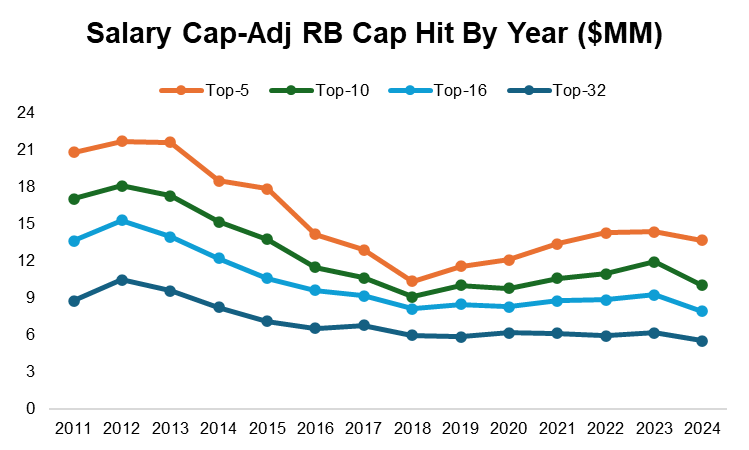Eight months ago, I argued labor conditions were bad enough for NFL running backs that they should form their own union. At the time, teams were firing top-10 RBs to get out of their contracts. The Bengals threatened Joe Mixon with the open market and he took a 40% salary cut instead. The Chargers told Austin Ekeler if he wanted a real raise he could find another team (spoiler: he couldn’t). Star running backs refused to come to work without new deals. Teams rolled their eyes and stood their ground. One (Jonathan Taylor) got his deal - a 3-year, $42M extension - but the other two (Josh Jacobs and Saquon Barkley) slunk back, tails between their legs, on one-year prove-it deals.
Well, here we are nearly a year later and it’s time to check back in. The NFL labor market is back and, as of Monday, was open for business! Running backs were front and center. The malcontents seemed to be handsomely rewarded: Barkley got a $45 million, 3-year contract from the Eagles, and Jacobs got $48 million, 4-year contract from the Packers. Multiple other teams signed running backs to $20+ million deals, including my Chicago Bears1.
On the surface, this is a step forward. Advancement! Labor peace! But all of it must be viewed through the biggest labor news of the summer: a $30M salary cap spike. The cap is what it sounds like, a limit on what teams can play their players. The player’s union negotiates this as a % of NFL earnings each year, meaning business last year must have been gooood.
Other than a brief dip due to COVID (the 2020 cap was announced pre-lockdown), the cap steadily increases every year. Until this year. The increase this year basically matched the increase over the last 5 years.
With an unprecedented pool of money in the market, and a lot of top running backs seeing their contracts expire, it was a perfect time to be a free agent running back. The key to negotiation is good outside options. Having many teams with no starter and money to burn is a beautiful thing.
And yet… the deals were still bad. Much worse than the headline reports. I’d argue the running back situation is worse than ever.
Three ways to see this. First, the top of the market. Of the 15 running backs with the highest 2023 cap hits, three were rookies on guaranteed deals. Of the remaining 12:
6 - his team let him go in free agency
2 - his team cut him for a younger replacement (Jones & Mixon)
3 - public reporting suggests his team will demand a pay cut to keep him around
1 - Jonathan Taylor
I’ve shown these new contracts in terms of guarantees, which are far less than the headline figures. That’s because teams love to tack on unguaranteed years to the end of the contract as free call options. If he plays great, keep him; if he doesn’t, sayonara. These unguaranteed years mean nothing, and it’s a bleaker picture without them2. Josh Jacobs went from a 1 year, $11.8M contract to… a 1 year, $12M contract with non-guaranteed funny money. The signing bonus advances a couple million, but a $48M offer it is not.
The story holds true for other big signings. Only Saquon got a guaranteed 2nd year: for everyone else, teams can cut and run if this season doesn’t work out. Those running backs better rent, not buy.
Another way to see this is adjusting the new salaries for cap inflation. Unadjusted, the average 2024 cap hits for running backs would be about equal to last year’s group. This is true no matter how you slice it - the top 10, top 15, all starters, etc. You can read that two ways:
(a) Running backs are getting as much as they ever have!
(b) The cap went up 14%, and running backs got none of it
We need to adjust these figures to account for the rising tide that should be lifting all boats. The chart below does just that, adjusting all running back salaries to 2024 cap dollars - i.e., making them the same as a % of the total cap.
By this measure, running backs are making 40% less than they did in 2011. And after the market had rebounded slightly for the top half of starters, they gave back all the gains this year.
Our third way of looking at this tells a similar story: last year wasn’t a low-water mark for the position, it was actually a pretty good one. This way takes into account the % of spending NFL teams have made on all running backs, not just their starters.
Like in the last graph, we see salaries reaching a floor around 2018, before a nice five-year run-up3. Then it falls off a cliff again, to lower levels than ever.
Time to get those union cards.
All data from Spotrac / OverTheCap.
Like any lifelong Bears fan, the best analogy for my relationship with the team is an emotionally abusive marriage.
I wish running backs would wise up and stop asking for these. You don’t want to make a living selling near-free call options on your career. The only situation where the team picks it up is when it hurts you. What’s the difference to Josh Jacobs between his current contract and the one he had last year? It’s mostly illusory. If teams aren’t willing to guarantee more than one year, you’re better off hitting the market again and again.
The uncharitable trader might refer to this as a dead cat bounce. But, to be clear, that’s what an uncharitable trader would say. I am definitely not saying that.





